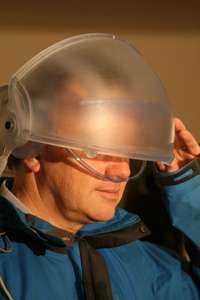The first virtual reality technology to let you see, hear, smell, taste and touch

(PhysOrg.com) -- The first virtual reality headset that can stimulate all five senses will be unveiled at a major science event in London on March 4th.
What was it really like to live in Ancient Egypt? What did the streets there actually look, sound and smell like? For decades, Virtual Reality has held out the hope that, one day, we might be able visit all kinds of places and periods as 'virtual' tourists.
To date, though, Virtual Reality devices have not been able to stimulate simultaneously all five senses with a high degree of realism.
But with funding from the Engineering and Physical Sciences Research Council (EPSRC), scientists from the Universities of York and Warwick believe they have been able to pinpoint the necessary expertise to make this possible, in a project called 'Towards Real Virtuality'.
'Real Virtuality' is a term coined by the project team to highlight their aim of providing a 'real' experience in which all senses are stimulated in such a way that the user has a fully immersive perceptual experience, during which s/he cannot tell whether or not it is real.
Teams at York and Warwick now aim to link up with experts at the Universities of Bangor, Bradford and Brighton to develop the 'Virtual Cocoon' - a new Real Virtuality device that can stimulate all five senses much more realistically than any other current or prospective device.
For the user the 'Virtual Cocoon' will consist of a headset incorporating specially developed electronics and computing capabilities. It could help unlock the full potential benefits of Real Virtuality in fields such as education, business and environmental protection.
A mock-up of the Virtual Cocoon will be on display at 'Pioneers 09', an EPSRC showcase event to be held at London's Olympia Conference Centre on Wednesday 4th March.
Professor David Howard of the University of York, lead scientist on the initiative, says: "Virtual Reality projects have typically only focused on one or two of the five senses - usually sight and hearing. We're not aware of any other research group anywhere else in the world doing what we plan to do.
"Smell will be generated electronically via a new technique being pioneered by Alan Chalmers and his team at Warwick which will deliver a pre-determined smell recipe on-demand. Taste and smell are closely linked but we intend to provide a texture sensation relating to something being in the mouth. Tactile devices will provide touch."
A key objective will be to optimise the way all five senses interact, as in real life. The team also aim to make the Virtual Cocoon much lighter, more comfortable and less expensive than existing devices, as a result of the improved computing and electronics they develop.
There has been considerable public debate on health & safety as well as on ethical issues surrounding Real Virtuality, since this kind of technology fundamentally involves immersing users in virtual environments that separate them from the real world.
Professor David Howard says: "In addition to the technical development of the Virtual Cocoon, we aim to closely evaluate the full, far-reaching economic and other implications of more widespread application of Real Virtuality technologies for society as a whole."
Source: Engineering and Physical Sciences Research Council





















